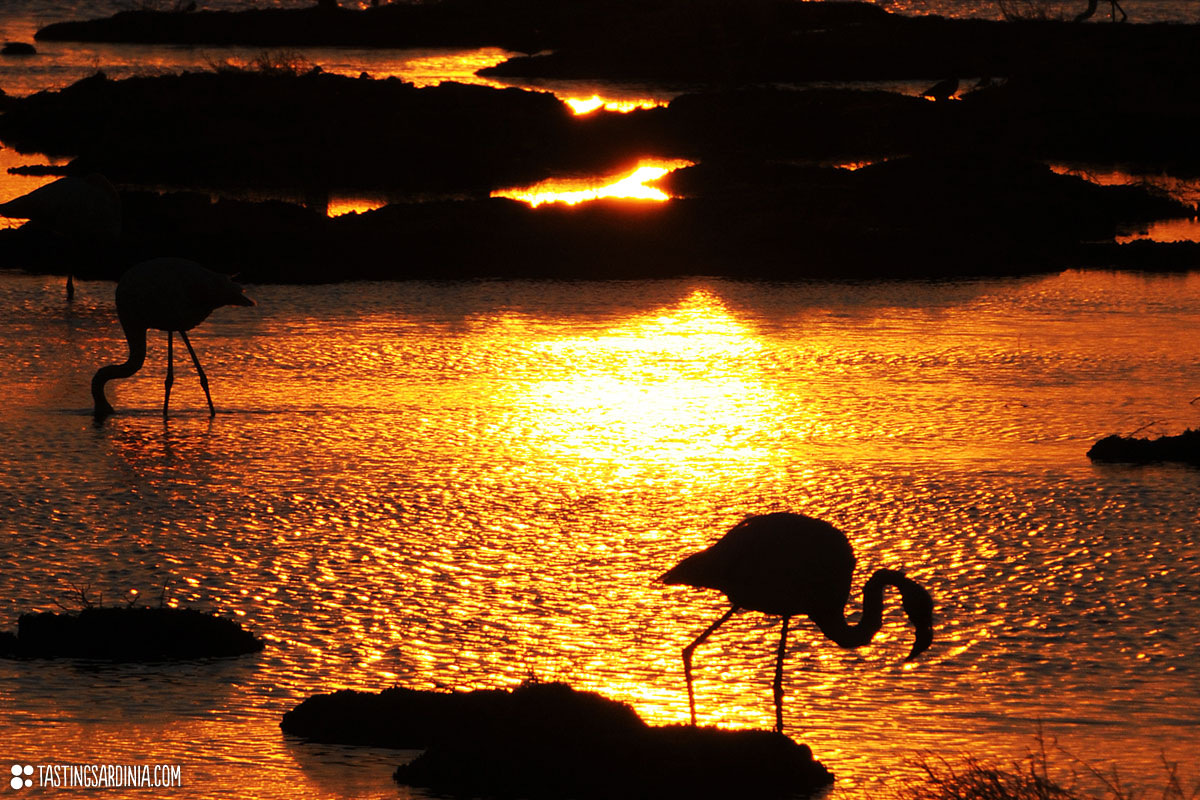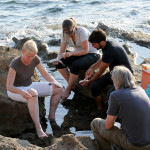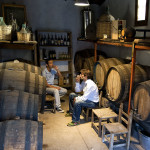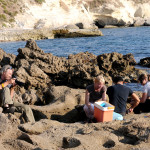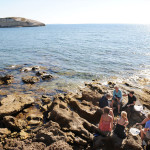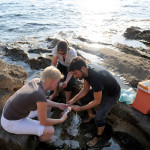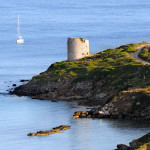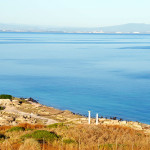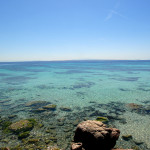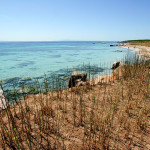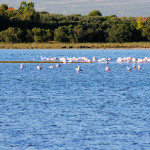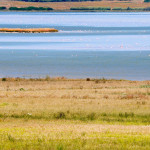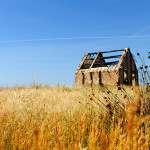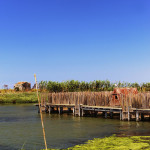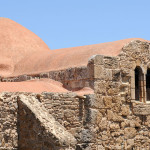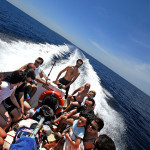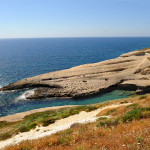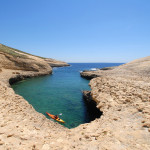5/8 day tour
Immerse yourself in the comfy atmosphere of Hotel Lucrezia, a beautifully restored traditional house; use the food as a shortcut to approach the Sinis unique culture making cooking classes and market visits; enjoy the delicious wines making cellar tours and tastings; learn about the immense archeological treasure visiting Tharros, the Mont’e Prama Giants and Nuraghe Losa; be overwhelmed by the beauty and sea colours of Mal di Ventre island; be amazed by the uncontaminated quartziferous gritty beaches considered a jewel of Sardinia; enjoy the pristine Sinis Peninsula park making local fish-farm visits and trekking to the costal towers; get a sense about their customs through traditional music demonstrations and dances.
- escorted by a local insider;
- max 8 people tour;
- minivan with private driver;
- meals included;
- transfers from/to airport include;
Tell us about your days permanence and we will build your tour.
Flat with a poetical acceptation. It’s difficult to find words to describe such a marvellous place. Fairly far from the most widely-known and summer-crammed parts of the island, the marine protected area of the Sinis Peninsula is a world apart. Its rich wetlands with crystalline lagoons, several kilometres of white quartz beaches and the crystal-clear sea, the swarming flocks of birds dotted every now and then by pink flamingos are framed in the low-lying green environment that appears uncontaminated by any human activity. The territory comprised in the protected area is extremely heterogeneous, with naturalistic and archaeological features of immense importance. The shape of the coast is in some stretches low and sandy, in others rocky with small reefs or with imposing cliff formations. Towards the north the coast is characterized by low reefs and beautiful long quartziferous sandy beaches such as Is Arutas and Mari Ermi, with stretches of dunes towards the hinterland covered by a typical Mediterranean vegetation. All this countryside richness only smeared by the blooming of the wild flowers was not neglected by the ancient populations: in fact, the whole peninsula has been settled since the 5th century BC. The almost 100 megalithic Nuraghes litter the landscape and the stunning Punic-Roman site of Tharros place proof to the area’s former influence.
The mild and hospitable character of the natives, complete, together with the rich food tradition the canvas. On the menu the meats of the “slow food labeled” red ox, the delicious and unique casigiolu cheese and last but not least grey mullet with its unbelievable roe bottarga: the Sardinian Caviar, obligatorily to be washed down by a sip of the local vernaccia wine.
Visit the largest fish market in Europe and tasting
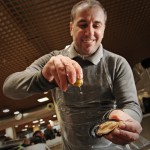 It is a complete and intense experience, if you are a great lover of the good cuisine you are going to love it. Is held at San Benedetto market one of the most fascinating and colourful places in Cagliari. It is considered to be the largest covered fish market in Europe.
It is a complete and intense experience, if you are a great lover of the good cuisine you are going to love it. Is held at San Benedetto market one of the most fascinating and colourful places in Cagliari. It is considered to be the largest covered fish market in Europe.
While strolling the market throughout the shoutings of the characteristics fishmongers that try to communicate with the farthest stall to ask about the remaining species we will get the chance to make a real tasting of the freshest fish on display. Shrimps, see urchins and oysters just to mention a few. We will grab some slices of grey mullet roe, the pricy and well known bottarga with its unmistakable strong flavor or you will have the chance to taste the touching raw mussels just with few drops of lemon on them. On the first floor a huge variety of cheeses from the whole island, especially the pecorino will be waiting for us to be tried, framed with the colours of the vegetables and the fruits of Sardinia.
Cookery experience
The beautiful Hotel Lucrezia, the core of our cooking lessons, is an ancient house located in the village of Riola Sardo. It’s the closest to the seaside among our locations, consequently the experiences that revolve around this dwelling are actively characterized by sea products. In this experience you will discover all the secrets of how to find, buy and cook a smooth and delicious Sardinian fish soup with a huge selection of different species cooked all together in the same cauldron.
You will be taught all the tips to recognize the freshest fish, which choice works better for a perfect combination of flavours according with what is reasonably fresh and priced and you will learn lots of traditional recipes that are easy to reproduce at home with your friends.
Pontis fish farm tours and meals
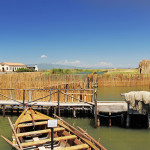 Eating in the Pontis fish farm is not only guarantee of good cuisine and freshest products, it is also a travel back in time to discover and appreciate the precious traditions of a territory rich in charm and magic. Within the main Peschiera Pontis complex, and just two steps away from the famed Cabras lagoon you will have the opportunity to visit the structures where, techniques and ancient tools for the farming of the grey mullet are jealously kept. In this unique environment you will be surrounded by the simplicity, spontaneity and innate sense of hospitality of the Cabras fishermen.
Eating in the Pontis fish farm is not only guarantee of good cuisine and freshest products, it is also a travel back in time to discover and appreciate the precious traditions of a territory rich in charm and magic. Within the main Peschiera Pontis complex, and just two steps away from the famed Cabras lagoon you will have the opportunity to visit the structures where, techniques and ancient tools for the farming of the grey mullet are jealously kept. In this unique environment you will be surrounded by the simplicity, spontaneity and innate sense of hospitality of the Cabras fishermen.
Wine tasting
The renowned guide book Lonely Planet write that: “the stunning backyard oasis of the Hotel Lucrezia is just waiting to be lived while sipping a glass of white wine resting under the cool pergola”. Now try to imagine yourself immersed in this exclusive ancient house, enjoying the garden breeze while taking part in the beautiful formative wine tasting we will have organized. The tasting will be mostly centred on sensory examination and evaluation of several white and red wines. The professional wine tasters will help you describe the range of perceived flavours, aromas and general characteristics among the wines chosen.
Meet Vernaccia wine producers in their astonishing unfired clay cellars. Visit the oldest vineyard in the Mediterranean area and the Contini winery
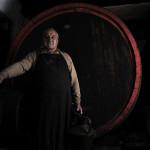 Meet the wine producers in their ancient unfired clay cellars accompanied by a local wine expert. This ancient cellars were not altered along the centuries with their walls made of unfired clay bricks respecting the tradition of the place. We have the chance to chat with some wine producers learning how this sherry-like wine is made and all the secrets to age this precious wine as the ancient system of “fractional blending”.
Meet the wine producers in their ancient unfired clay cellars accompanied by a local wine expert. This ancient cellars were not altered along the centuries with their walls made of unfired clay bricks respecting the tradition of the place. We have the chance to chat with some wine producers learning how this sherry-like wine is made and all the secrets to age this precious wine as the ancient system of “fractional blending”.
During the guided tour we match different levels of ageing with different kinds of local delicacies. From aperitif to desserts, especially those made with almonds, we pairing wines according with its ageing with fish, pasta, veal chops, shellfish, seafood, bottarga.
Visit the oldest vineyard in the Mediterranean with an archeologist and visit the Contini winery of Cabras complet the tour.
Bottarga making experience
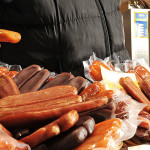 Bottarga has a famously rich, enticing flavour. Once known as the poor man’s caviar, this product is the salted, pressed and dried roe of grey mullet (lissa in Sardinian language, muggine or cefalo in Italian). It is a specialty of Sardinia and Sicily. To make bottarga, the entire long, fat roe sac is salted and massaged by hand over several weeks to eliminate air pockets. The roe is then pressed using wooden planks and stone or marble weights and sun-dried for one to two months.
Bottarga has a famously rich, enticing flavour. Once known as the poor man’s caviar, this product is the salted, pressed and dried roe of grey mullet (lissa in Sardinian language, muggine or cefalo in Italian). It is a specialty of Sardinia and Sicily. To make bottarga, the entire long, fat roe sac is salted and massaged by hand over several weeks to eliminate air pockets. The roe is then pressed using wooden planks and stone or marble weights and sun-dried for one to two months.
The heritage of farming the nutrient-rich sea salt of the tidal marshes and using it to preserve the marshes seafood is maintained to this day exclusively in in the Sinis peninsula. You will have the chance to learn this ancient tradition of air-curing grey mullet from the Cabras fishermen, who brought the custom to the rest of the world.
Tharros
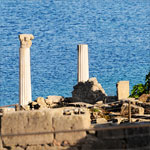 The promontory of San Marco, where Tharros lies, is the extreme end of the Sinis peninsula. The presence of humans in this part of the Island is attested to the pre-Nuragic civilization and among the 100 Nuraghes scattered in the whole Sinis at 4 were found in the promontory. By the way the city was established by the Phoenicians in the 8th century BC and has historically had a very complex multilayered stratification being conquered by the Punics first and the Romans later. It reached its most prosperous time in the 4th century AD, then it started to decline even though it had been inhabited since medieval times. Tharros was a major city in ancient times and its ruins today are considered to be an open-air museum, a must visit.
The promontory of San Marco, where Tharros lies, is the extreme end of the Sinis peninsula. The presence of humans in this part of the Island is attested to the pre-Nuragic civilization and among the 100 Nuraghes scattered in the whole Sinis at 4 were found in the promontory. By the way the city was established by the Phoenicians in the 8th century BC and has historically had a very complex multilayered stratification being conquered by the Punics first and the Romans later. It reached its most prosperous time in the 4th century AD, then it started to decline even though it had been inhabited since medieval times. Tharros was a major city in ancient times and its ruins today are considered to be an open-air museum, a must visit.
Cabras museum
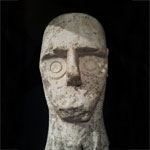 The Cabras museum has always been represented a worth-visiting site in the Sinis area since it can count on remarkable peaces dating back to the Bonu Ighinu culture (5000 bc), or the Ozieri culture (3000/3500 BC). It is fair to say anyhow that with the recent findings and recovery of the Giants of Mont’e Prama things have changed dramatically. For the better. It is not outrageous, considering the huge clamour that they have raised everywhere, to consider the discovery as the new archeological highlight of the Island.
The Cabras museum has always been represented a worth-visiting site in the Sinis area since it can count on remarkable peaces dating back to the Bonu Ighinu culture (5000 bc), or the Ozieri culture (3000/3500 BC). It is fair to say anyhow that with the recent findings and recovery of the Giants of Mont’e Prama things have changed dramatically. For the better. It is not outrageous, considering the huge clamour that they have raised everywhere, to consider the discovery as the new archeological highlight of the Island.
The Giants are ancient stone sculptures, 2 metres (6 feet) high and carved by the Nuragic civilization. According to the most recent estimates, the fragments came from a total of forty four statues. Those already restored and assembled are twenty five, in addition to thirteen nuraghe models, while another three statues and three nuraghe models have been identified from fragments that cannot currently be re-assembled. Some of the statues are on display in the main Cagliari museum, while the rest is standing proudly in the Cabras structure.
Nuraghe Losa
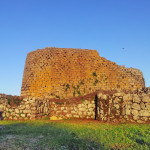 The Nuraghe Losa is considered to be one of the most well preserved Nuraghe of the whole island. Famous also for its size and particular structure it is completely surrounded by a wider wall, which encoloses the settlement of the original village of huts and other additional buildings constructed in the late-Punic and imperial Roman periods.
The Nuraghe Losa is considered to be one of the most well preserved Nuraghe of the whole island. Famous also for its size and particular structure it is completely surrounded by a wider wall, which encoloses the settlement of the original village of huts and other additional buildings constructed in the late-Punic and imperial Roman periods.
The costal towers stroll
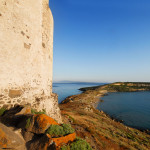 Different authors ascribe to the territory of Cabras five coastal towers, three of which are directly situated on the coast. They had the task to watch over the coasts in order to prevent the frequent incursions by the so-called barbareschi, as well as to prevent the landing of infected boats or boats suspected of smuggling. The surveillance was particularly important near the fish pools, like in Cabras, which was more than once subject to pirate attacks.
Different authors ascribe to the territory of Cabras five coastal towers, three of which are directly situated on the coast. They had the task to watch over the coasts in order to prevent the frequent incursions by the so-called barbareschi, as well as to prevent the landing of infected boats or boats suspected of smuggling. The surveillance was particularly important near the fish pools, like in Cabras, which was more than once subject to pirate attacks.
Mal di ventre Island boat tour
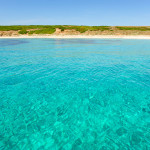 The Island of Mal di Ventre is what has remained of a large granite outcrop which covered the whole western coast of Sardinia in very ancient times.
It has a surface of about 80 hectares (about 200 acres) and is about 5 nautical miles from the coast; it maximum height on the sea level is less than 20 metres (65 feet).
The weathering of its rocks feeds the sands of the quartziferous beaches of the Sinis. The landscape is characterized by the intrusive granite rocks with particular shapes resulting from the erosive action of the often exceptional forces of nature which sometimes create shapes which have been transformed by the popular imagination into persons, things, or animals. The whole tiny island can be easily strolled on foot in less than 2 hours and conformation of the two sides (north and south) is incredibly different. The landscape and the sea colours are extremely compelling. Here is the perfect spot to enjoy a walk through the peculiar wind-bent scrub or to bath while snorkelling among the colourful fish of the protected park.
The Island of Mal di Ventre is what has remained of a large granite outcrop which covered the whole western coast of Sardinia in very ancient times.
It has a surface of about 80 hectares (about 200 acres) and is about 5 nautical miles from the coast; it maximum height on the sea level is less than 20 metres (65 feet).
The weathering of its rocks feeds the sands of the quartziferous beaches of the Sinis. The landscape is characterized by the intrusive granite rocks with particular shapes resulting from the erosive action of the often exceptional forces of nature which sometimes create shapes which have been transformed by the popular imagination into persons, things, or animals. The whole tiny island can be easily strolled on foot in less than 2 hours and conformation of the two sides (north and south) is incredibly different. The landscape and the sea colours are extremely compelling. Here is the perfect spot to enjoy a walk through the peculiar wind-bent scrub or to bath while snorkelling among the colourful fish of the protected park.
The best beaches
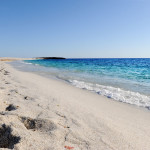 The Marine Protected Area of Penisola del Sinis-Isola di Mal di Ventre is characterized by fifteen kilometers of amazing and uncontaminated beaches. The most pristine and sought after are Sa mesa Longa, La Caletta, San Giovanni, Funtana Meiga, Maimoni, Is Arutas and Mari Ermi; the latest two are several kilometres long and are just stunning. This white strips of land are brilliantly matched with the colours of the sea that turns slightly to green and blue. This tract of coastline differs from the other coasts of Sardinia, because they are composed of porphyritic granite instead of the common calcareous rock. The seabed consists of colourful quartz grains which are the result of a long chemical evolution and atmospheric processing. This corner of Sardinia is unique and wild. It provides the basic services, but it is a destination far from the mass tourism of certain parts of the coast.
The Marine Protected Area of Penisola del Sinis-Isola di Mal di Ventre is characterized by fifteen kilometers of amazing and uncontaminated beaches. The most pristine and sought after are Sa mesa Longa, La Caletta, San Giovanni, Funtana Meiga, Maimoni, Is Arutas and Mari Ermi; the latest two are several kilometres long and are just stunning. This white strips of land are brilliantly matched with the colours of the sea that turns slightly to green and blue. This tract of coastline differs from the other coasts of Sardinia, because they are composed of porphyritic granite instead of the common calcareous rock. The seabed consists of colourful quartz grains which are the result of a long chemical evolution and atmospheric processing. This corner of Sardinia is unique and wild. It provides the basic services, but it is a destination far from the mass tourism of certain parts of the coast.
Launeddas private performance
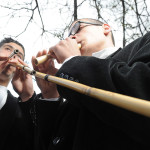 We are proud to let you discover one of the most ancient woodwind instruments of Sardinia simply made out of reed and played with a continuous mouth-blown technique (circular breathing). The most ancient proof of the existence of launeddas in Sardinia is given by the little votive bronze statue called bronzetti dating back to the X c. BC in the nuraghe period. It is a polyphonic instrument made of three pipes. The circular breathing technique allows the musician to play them simultaneously: one of the pipes as a drone while the other two playing the melody.
We are proud to let you discover one of the most ancient woodwind instruments of Sardinia simply made out of reed and played with a continuous mouth-blown technique (circular breathing). The most ancient proof of the existence of launeddas in Sardinia is given by the little votive bronze statue called bronzetti dating back to the X c. BC in the nuraghe period. It is a polyphonic instrument made of three pipes. The circular breathing technique allows the musician to play them simultaneously: one of the pipes as a drone while the other two playing the melody.
- Kookery experience
- Pontis fish farm tours and meals
- Wine tasting
- Bottarga making experience
- Tharros
- Cabras museum
- Nuraghe Losa
- The costal towers stroll
- Mal di ventre Island boat tour
- The best beaches
